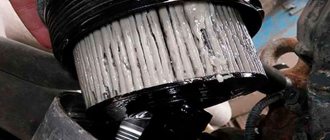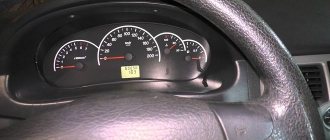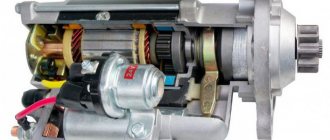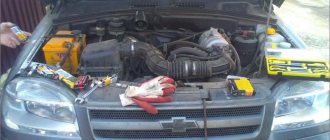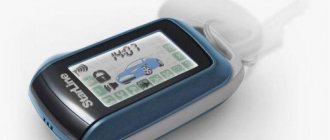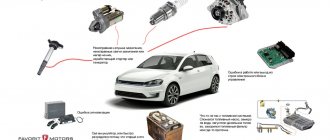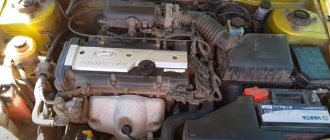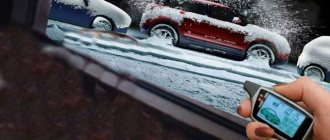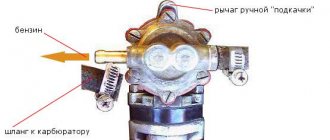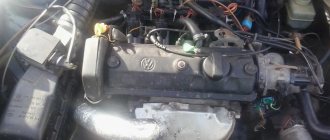Our material is devoted to one of the common problems - difficulties with starting the engine in the domestic small car Lada Kalina.
If, at the first attempt, the engine in a Lada Kalina, which has an 8-valve engine, refuses to start, then this indicates the presence of some problem. The reasons for this “behavior” of how difficult it is to start when cold are varied, so let’s focus on the main and common factors that cause this unpleasant situation.
So, the reasons for an uncertain launch or its absence:
- Insufficient fuel pressure level in the injection system rail. When the car is idle for a long time, the pressure inside the ramp tends to decrease and then it is difficult to start when cold. For flawless engine starting, stable operation of the fuel pump is required, which ensures the operating pressure value. When the fuel system filter is partially worn out or clogged, it is unlikely that the power unit will be able to start the first time. When restarted, the sediment creates a sufficient level of pressure necessary to supply the required volume of mixture inside the chambers, and the engine begins to function. And these are not all the reasons for this problem.
- The ignition coil has become unusable. This problem is typical not only for 8-valve versions of LADA Kalina engines, but also for their 16-valve counterparts. If the coil functionality is insufficient, starting the engine on the first try is also unlikely. This malfunction clearly manifests itself in damp weather or during frosty periods; it is difficult to start in cold weather.
- The crankshaft position sensor is faulty. Such a breakdown occurs very rarely, but if it occurs, the engine will not start due to the lack of a spark.
- The idle air control (IAC) or throttle position sensor (TPS) has failed. If there is a malfunction of the specified electronic components of the intake system, the LADA Kalina engine will also start unstably. Not in every case the on-board controller will be able to come to the rescue in the form of displaying the fact of a breakdown on the monitor. An effective method of identifying a defect is to replace the designated “suspects” with known-good analogues.
- Gasoline of insufficient quality. This is a fairly common reason that causes the engine to start hesitantly, a common reason when it is difficult to start when cold. Here you will need to change the fuel supplier (gas station) and then draw certain conclusions based on the changed behavior of the car.
- Engine starting is blocked by the immobilizer. Many owners of the Lada Kalina, if it has 8 valves, are aware of this problem, and some have already encountered it firsthand. Sometimes retraining the key helps. If there is no result, then you will need to disable the security system or repair it. If you do not have enough experience, we recommend contacting a professional.
Reasons why it is difficult to start when cold
It is important to distinguish between situations in which problems arise: the car is hot and has difficulty starting, it has difficulty starting after being idle, when it cools down, (especially in the morning) if it refuses to start in cold weather. They all have their own nuances and reasons that should be considered separately .
We will understand in general terms what reasons lead specifically to poor starting of a cold engine. Usually one or two rotations of the starter armature shaft are enough to start a car in good condition. If this cannot be done, you need to look for why.
Main reasons:
| Causes | Carburetor | Injector | Diesel |
| Low fuel quality | |||
| Poor fuel pump performance | |||
| Clogged fuel filter | |||
| Low fuel pressure | |||
| Low fuel level in carburetor | |||
| The pressure regulator in the fuel line is faulty | |||
| Air leak | |||
| Poor condition of spark plugs | |||
| Malfunction of high-voltage wires or ignition coils | |||
| Dirty throttle valve | |||
| Idle air valve contaminated | |||
| Malfunction of air sensor indicators | |||
| Engine temperature sensor glitch | |||
| Valve clearances are knocked down or incorrectly set | |||
| Incorrect oil viscosity (too thick) | |||
| Low battery charge |
In addition to these cases, there may be others, less common, but equally significant. We will also mention them below.
Troubleshooting Tips
On gasoline engines, an indicator that it is difficult to start and stalls when cold can be a spark plug . We unscrew it and look: if it’s flooded, it overflows, we look further down the points; dry - lean mixture, we also sort out the options. This method of analysis will allow you to start finding out with simpler ones and gradually approach more complex reasons for poor engine starting when cold, rather than looking for them in the fuel pump, disassembling the injector, getting into the timing mechanism, opening the cylinder block, etc.
But for a diesel engine, the first on the list of faults will be weak compression . So owners of diesel cars should pay special attention to it. In second place is the quality of the fuel or its inconsistency with the season, and in third place are glow plugs .
Tips for starting the engine in cold weather
- Keep the tank full - this will prevent condensation from forming and water will not get into the fuel.
- Turning on the high beams for a couple of seconds before starting will restore some of the battery capacity on frosty days.
- After turning the key in the ignition switch (on an injection car), wait a few seconds until normal pressure is created in the fuel system, and only then start the engine.
- Pump up gasoline manually (on a carburetor car), but you must not overdo it, otherwise the spark plugs will flood.
- Cars run on gas, under no circumstances should you start them cold, switch to gasoline first!
How to check the ignition system
The ignition system consists of high-voltage wires, spark plugs, a coil and an electronic control unit. In wet weather, and especially after heavy rain, the car may not start properly due to excess moisture getting into one of the ignition devices.
First, open the engine hood and try to wipe with a dry cloth all the wires and devices responsible for igniting the fuel. These are high-voltage cables, ignition coils and connectors on the control unit. It is also good to use chemical drainage fluids.
After cleaning and securing the necessary parts, the drive can be restarted using the starter. If even after this procedure it does not start, check the spark coming from the spark plugs.
To do this, unscrew one of the plugs and attach it to the crankcase, and then start the engine again using the crank. A fairly distinct spark should flicker from the removed spark plug. If it flashes, it means the spark plug is good. The procedure is performed with all plugs installed. If one of them has no spark, replace the part and try restarting the engine. If the unit does not restart, disconnect the connectors from all sensors in the power supply and protect them with moisture, then wipe with a cloth. Then try restarting the engine. In case of another unsuccessful attempt, you can safely leave the car alone and call a tow truck. What can be done in this case has already been done, and only further diagnostics using specialized equipment can help.
The injector does not start well when cold
The first thing you should pay attention to when an injection car is performing poorly is the sensors. Failure of some of them leads to difficulty starting the engine, since incorrect signals are sent to the ECU. It is usually difficult to start when cold due to :
- coolant temperature sensor, DTOZh informs the control unit about the state of the coolant, these indicators affect engine starting (unlike a carburetor car), adjusting the composition of the working mixture;
- throttle sensor;
- fuel consumption sensor;
- Mass air flow sensor (or MAP, intake manifold pressure sensor).
Often there is a problem with cold starting due to the fault of the fuel pressure regulator . Well, of course, whether it’s an injector or a carburetor, when a cold car doesn’t start well, if it stalls, the speed jumps, but after warming up everything is fine, then it’s imperative to check the condition of the spark plugs, and use a multimeter to check the coils and explosive wires.
Leaking injectors cause a lot of trouble when it’s hot outside, the car will have difficulty starting on a hot engine, and in the cold season a dripping injector will cause difficulty starting in the morning . To test this theory, it is enough to simply release the pressure from the vehicle in the evening so that there is nothing to drip, and look at the result in the morning.
We cannot exclude such a banal problem as air leaks in the power system - it complicates starting a cold engine. Also pay attention to the fuel poured into the tank, since its quality greatly affects engine starting.
On cars such as the Audi 80 (with a mechanical injector), we first check the starting injector.
Checking and setting up the immobilizer
Immobilizer “glitches” appear due to the fact that in many car models from domestic and foreign manufacturers the ECU controller is located near or under the fan heater radiator.
If the car does not start the first time, the heater panel is removed and the ECU is visually checked. It should be dry. A wet ECU signals failure. If water gets on it, this device cannot be repaired, only replaced.
Immediately from exposure to moisture, the output key of the unit burns out. Craftsmen can resolder this chip, but it will not last long - two or three months at most. A coolant leak can be eliminated by replacing the heater core. It is recommended to install a new controller between the heater and the engine compartment panel. Immobilizers of any model do not fail without reason. The breakdown of the unit presumably occurs from the control panel or faulty wiring.
The keychain usually consists of two halves, held together with a self-tapping screw. The screw may not be tightened or may be overtightened. As a result, a crack appears between the transponder contacts of the remote device microcircuit. If the car engine does not start the first time, you need to try starting it with a training or spare key or change the remote control. When the immobilizer was thoroughly checked, there are no signals, but the car still does not start, the starter is checked.
The carburetor does not start well when cold
Most of the reasons that an engine with a carburetor does not start well, or does not start at all, is due to malfunctions of such elements of the ignition system as: spark plugs, explosive wires, coil or battery. Therefore , the first thing to do is to unscrew the spark plugs - if they are wet, then the electrician is to blame.
The main reasons why the carburetor does not start when cold:
- Ignition coil.
- Switch.
- Distributor (lid or slider).
- Incorrectly adjusted carburetor.
- The starter diaphragm or the fuel pump diaphragm is damaged.
Of course, if you pump up gasoline before starting and pull out the choke more, it will start better, but all these tips are relevant when the carburetor is correctly configured and there are no problems with the switch or spark plugs.
Advice from an experienced VAZ 2110 car owner: “When the engine does not start on a cold engine, you need to smoothly press the gas pedal all the way, turn the starter and release the pedal back, as soon as it grabs, keep the gas in the same position until it warms up.”
Let's look at some typical cases when it won't start when cold:
- when the starter turns but does not engage, it means either there is no ignition to the spark plugs, or gasoline is not flowing either;
- if it seizes, but does not start, most likely the ignition or, again, gasoline is faulty;
- If the starter does not turn at all, then the battery is probably dead or something related to it.
Why is it difficult to start a cold carburetor?
If everything is normal with oil, spark plugs and wires, then the ignition may be late or the starting valve in the carburetor is not adjusted. However, there may also be a torn membrane in the cold start system , and the valve adjustment also says a lot.
Lada Granta Lucky › Logbook › In the morning Granta starts the second time. Solution
With the arrival of lower temperatures in the fall, +2 during the day and at night below -1, I noticed such a strange feature that in the morning when starting the car it starts without problems, but it runs for 2-4 seconds and immediately turns off as if I had specially turned it off with the key. And this is only in the morning, throughout the whole day everything works as soon as it came from the factory.
I looked at similar problems on the Internet, the solution is different everywhere and not for Grant, supposedly the idle speed sensor is covered and the like. I’ll say right away that I was also thinking about it, but after looking at the technical instructions for the module I realized that there are no floating speeds and it’s almost impossible to refuse, except for the fact that “carbon deposits” form on the air damper and you have to pay 4,000 rubles for the module because it’s a sensor located in it and not sold separately, I didn’t see the point. As a result, I came across a post www.drive2.ru/l/3061895/ where a fellow sufferer, also with a similar problem, had already tried to solve it. I decided to change the battery because it was winter and the factory one was already 3.5 years old. Allegedly, on old Viburnums, due to a weak battery, the on-board power goes out in the morning when starting up, and the ECU, seeing this, forcibly turned off the engine. As a result, I bought a Topla 60Am/h battery with a starting current of 510 for a price of 3800. And I started waiting for the next morning to check if it would help or not. As a result, the new battery has the same problem.
I came across another post www.drive2.ru/l/8154330/ where the same fellow sufferer had already changed the fuel pressure valve, which is located in the fuel pump module, did not wait long and went for a new valve, 500 rubles for the valve itself and the rubber seal between the module and a body, which was not useful at all, but it costs 100 rubles. As a result, I started replacing it, I’ll say right away that if you take out the fuel pump, be careful with the fuel level sensor (the float hanging on the L-shaped wire) because when I removed it, I did something to it, which is why it stuck and showed an empty tank. I had to take it out several times to fill everything under the seat with gasoline in order to return the stuck part to the dangling mode)) (I just moved my fingers, twisted it so that it began to move more or less freely and lowered it back into the tank) Another nuance when removing it, I did not see how the O-ring was standing, so initially I simply installed it on top, after which I could not understand why the retaining ring did not want to fit into the grooves. DO NOT REPEAT my mistake otherwise you will swear. Correctly it should be put on the gas tank opening itself.
The O-ring is positioned correctly. For pioneers like me
And one more nuance, wipe everything very well from dirt and especially under the sealing ring, there are such sockets there. As a result, while I was struggling with the float, this is what I noticed: when I had the old valve installed, when I removed the tubes from the module for the first time, it didn’t even spray due to the lack of pressure, and when I had already replaced it with a new one, I started removing it a second time , squeaked so hard it hit the back of the seat. Already at that moment it became clear that the old thing had come to an end. Now I’ll wait for the next morning to finally be happy, or maybe upset again)))) I didn’t take any photos because there is a lot of information on removing the fuel module and replacing the valve on the Internet or in a book who has it. By the way, there was a lot of dirt in the tank. It needs to be washed in the summer. It took a little over an hour, everything was simple and easy) The tool included a hammer (for knocking out the retaining ring), 2 types of screwdrivers and that’s it) and a lot of rags for wiping off dirt and gasoline.
Difficult to start on cold diesel
As you know, starting a diesel engine occurs due to temperature and compression, therefore, if there are no problems with the battery and starter, there may be 3 main ways to find the reason why a diesel engine does not start well in the morning when it’s cold:
- Insufficient compression.
- No glow plug.
- is missing or interrupted .
One of the reasons that a diesel engine does not start when cold in particular, and poor diesel starting in general, is poor compression . If it doesn’t start in the morning, but seizes from the pushrod, and then there is blue smoke for a certain time, then this is 90% low compression.
Checking engine compression
Checking engine compression with a compression gauge and without instruments with your own hands. How to measure compression in gasoline and diesel engines. Compression diagnostics. More details
An equally common case is when the owner of a car with a diesel engine cannot start a cold engine, but a hot one starts without problems - if there is no glow on the spark plugs . Glow plugs heat diesel fuel until the diesel engine reaches operating temperature completely.
There may be three options why the candles do not work
- the spark plugs themselves are faulty;
- It's the spark plug relay. Its operation is regulated by the coolant temperature sensor. During normal operation, the relay makes quiet clicks when the key is turned in the ignition before starting, and if you cannot hear them, then you should find it in the block and check it;
- oxidation of the glow plug connector. There is no point in explaining how oxides affect contact.
3 options for checking glow plugs
To check diesel spark plugs, you can choose several methods :
- measure their resistance (on an unscrewed spark plug) or an open circuit in the heating circuit with a multimeter (checked in the beeper mode, both screwed into the engine and after unscrewing it);
- check the speed and degree of heating on the battery by connecting to ground and the central electrode with wires;
- Without unscrewing it from the engine, connect the central wire to the positive terminal of the battery through a 12 volt light bulb.
If the spark plugs are working and they are properly supplied with power when the ignition is turned on, then in some cases it is necessary to check the valve clearances. Over time, they become confused and do not close completely when the internal combustion engine is cold, but if you start it and warm it up, they close up and the engine starts normally when it is hot.
Faulty diesel injectors , as a result of natural wear or contamination (sulfur and other impurities), are an equally important aspect. In some cases, the injectors throw a lot of fuel into the return line (you need to do a test) or the fuel filter is dirty.
Interruptions in the fuel supply make it much more difficult to start the engine. So, if the diesel engine stops starting in the morning, regardless of the temperature outside, the diesel fuel is leaving (the return valve does not hold), or it is sucking air, other options are less likely! Air entering the fuel system can cause the diesel engine to have difficulty starting and stalling.
Fuel is out of season or contains foreign impurities . When it is cold outside and the diesel engine does not start or immediately stalls after starting, then the problem may be in the fuel. DT requires a seasonal transition to “summer”, “winter” and even “arctic” (for especially cold regions) diesel fuel. A diesel engine does not start in winter because unprepared summer diesel fuel in the cold turns into a waxed gel in the fuel tank and fuel lines, and also clogs the fuel filter.
In this case, starting the diesel engine helps by heating the fuel system and replacing the fuel filter. Frozen water on the filter element presents no less difficulties. To prevent water accumulation in the fuel system, you can pour a little alcohol or a special diesel fuel additive into the tank, called a dehydrator.
Tips for diesel car owners:
- If, after pouring boiling water on top of the fuel filter, the car starts and works normally, the diesel fuel is summer.
- If there is low pressure in the fuel rail, the injectors are probably leaking and not closing (the operation is checked on a special stand).
- If the check shows that the injectors are pouring into the return line, then the needle in the sprayer does not open (they need to be changed).
10 reasons why diesel engines have trouble starting when cold
If a diesel engine has trouble starting when cold, the reasons can be collected in a single list of ten points:
- Starter or battery faulty.
- Insufficient compression.
- Faulty injector/injectors.
- Incorrectly set injection timing, desynchronization with fuel injection pump operation (timing belt jumps by one tooth).
- Air in fuel.
- The valve clearance is incorrectly set.
- Malfunction of the preheating system.
- Additional resistance in the fuel supply system.
- Additional resistance in the exhaust system.
- Internal breakdown of the injection pump.
I hope that all of the above will help you, and if it does not solve the problem of starting a cold engine, it will at least point you on the right path to eliminating it on your own or with the help of a specialist.
Difficulties starting the engine “cold” arise in different situations. Firstly, leaving the car in the cold for a long time. This could be one night or several weekends. Secondly, the cooling of the internal combustion engine after it has warmed up to operating temperatures, stopped and attempted to restart after some time.
Difficulty starting gasoline and diesel engines has similar causes, but manifests itself in different ways. This applies to engines with carburetor and injection fuel supply systems that have design differences.
In this article we will talk about common problems that lead to additional difficulties when trying to start the engine “cold”, we will give recommendations for owners of cars with power plants running on gasoline and heavy fuel.
Lada Granta does not start - spark plugs are in gasoline
If the unscrewed ones are wet, then it is logical to assume that gasoline is entering the cylinders. Accordingly, you need to dig towards the spark. Everything is definitely fine with the DPKV, because the ECU sees the scrolling and opens the injectors.
On a car with an 8-valve engine, where an ignition module is installed, this procedure is much simpler than on cars with a 16-valve engine. First, we need to make sure that voltage is supplied to the ignition module, namely, to the primary winding of the module. To do this, remove the chip from the module, and then turn on the ignition. There should be 12 volts between the center wire and ground. If they are not there, then check all the wiring to the control unit. If everything is fine with it, then with 90% confidence we can say that the problem is in the ECU. After we went to the cartoon, power is supplied, we check the module itself. To do this, use the same multimeter to check the resistance of the primary winding. It is measured between the second and third terminals of the coil.
The resistance should be about 1.2 kOhm. After this, we check the resistance of the secondary winding coils. To do this, it is measured between the terminals on high-voltage wires 1 and 4, as well as cylinders 2 and 3. This resistance may differ among different manufacturers, so here it is looked at relative to each other. On average, the indicator varies from 6.5 to 12. It is worth clarifying that this method of checking the module may not always be reliable, since the coil has different characteristics at different thermal conditions. It remains to check the high-voltage wires; we measure their resistance with a multimeter; it should be no more than 5 kOhm on the shortest wire, and no more than 10 kOhm on the longest wire, respectively. Unfortunately, checking high-voltage wires for breakdown at home is quite problematic; this may require at least a megaohmmeter. Many people, in the absence of a spark and wet spark plugs, immediately jump to check the crankshaft position sensor. Here it must be said that the fuel supply to the cylinder already indicates that this sensor is working. But how reliably it shows the position of the crankshaft is difficult to say. At home, it is easier to check the crankshaft position sensor by replacing it with a known good one.
This is a list of typical faults that cause Lada Granta to not start. It is worth noting that the actual list is much larger than this, since every case cannot be typical. It also happens that, for example, the injectors behave adequately when cold, but after warming up they begin to spray. But it happens the other way around: when it’s cold, they cannot provide sufficient performance, but when it’s hot, on the contrary, they work properly. Unfortunately, even in big cities it is often quite difficult to find a competent specialist in engine diagnostics. This line of work requires at least three elements to work. The first is a motor tester. They are quite extensive, so there is no point in considering them. The second is a diagnostic scanner. It is often very difficult to find a multi-brand scanner with good functions; in addition, its cost exceeds all reasonable limits. The third is a gas analyzer. Equipment for engine diagnostics alone costs at least 200 thousand. In addition, training takes quite a long time. Therefore, very few people are involved in diagnostics, if we talk about competent diagnostics. Well, one more case why the Lada Granta may not start. Video - Lada Granta does not start:
Preparatory activities
To simplify your task in finding the cause of the malfunction, check the following:
1. Presence of exhaust gases.
There should be light smoke coming from the exhaust system when the starter rotates. It indicates that fuel is entering the cylinders.
2. Battery charge level.
A completely discharged battery is one of the most common reasons why a car engine will not start. Therefore, we check the battery charge level.
3. Serviceability of the starter (the engine should spin without failure).
If the starter does not spin the crankshaft, then a dead battery is to blame. If not, then the problem lies elsewhere. For example, the contact between the ground and the starter housing has oxidized.
Starter and wiring
If this important device malfunctions, the flywheel either does not rotate, that is, it is silent, or it tries to spin, but cannot for some reason. There are clicks, metallic clangs, and dull thuds. You should immediately check the battery and charge it to maximum. When the battery is discharged, the lights in the cabin and on the instrument panel do not light up. If the lights are on, diagnostics are carried out.
The driver gets out of the car, leaving the high beams on. The lights are dim – the battery is weak. Its power is only enough to light the lamps, but the battery does not have enough strength to turn the engine flywheel. When the battery is fully charged, the density is normal, the electrolyte level is removed and the starter and current-carrying wires are checked.
The wiring is tested with a multimeter. The black wire is connected to ground, the red wire to the starter contact. Usually the device shows 12.5–14.5 V. If the device shows lower or zero numbers, the wiring is faulty. Contacts are cleaned, fuses and PVC wire sheath are checked.
If the current values are normal, the starter is changed. Clicks, jerks, and clanging noises when the battery is working indicate a faulty motor or retractor relay. Craftsmen fix these problems in garages, but modern car enthusiasts are already accustomed to contacting a car service center.
The main causes of problems during cold engine starts
Low quality fuel
The likelihood of refueling a car with low-quality fuel at certified gas stations in large cities is very low. It is much easier to encounter counterfeit products at little-known gas stations on the highways or when purchasing fuel second-hand. Such fuel does not pass quality control and contains a large amount of impurities that contaminate filters and fuel pipe channels. As a result, the pressure in the system decreases and the car does not start.
The use of low octane gasoline is determined by the following criteria:
- too noisy operation of the internal combustion engine;
- reducing the dynamic characteristics of the car;
- detonation.
In diesel engines, a problem may arise due to the fuel selected “out of season.” An owner who uses diesel fuel for the summer during the winter period of operation of the vehicle will encounter difficulties. The main reason is the discrepancy between the physical and chemical properties of the fuel and the operating conditions.
Possible faults
No matter how trivial it may sound, if the injector does not start, it means something has gone wrong. The success and speed of repair depends on how quickly and efficiently the problematic link in the car’s design can be identified. To better understand the essence of repair activities, it would be a good idea to pay attention to potential breakdowns. The basic list of the latter is as follows:
- Malfunctions of the injector itself. In the event of a breakdown of this kind, as a rule, the car does not start either cold or hot. On top of that, the injector indicator on the dashboard or on-board computer constantly lights up, signaling its malfunction. It is much less common for the engine to work when the indicator is on, but in this case the car starts poorly and is extremely unstable. It is worth noting that the injectors in the injector most often become clogged or the ECU burns out, so it is advisable to check these components first;
- Ignition system failures. Here the list of possible faults is quite large. Often the candles that suffer are simply flooded. In the event of such a breakdown, the car starts and immediately stalls, but in the long term it stops even “grasping.” Other components of the ignition system (coil, module, distributor, crankshaft sensor, etc.) are noticeably less likely to suffer;
- Incorrect operation of the fuel system. In this aspect, injection engines most often suffer on three fronts:
- Fuel filters are clogged (the car “picks up”, but does not start; if the engine starts, it is extremely unstable);
- The fuel pump is faulty (its characteristic operating sound is absent when you turn the ignition key, the injector itself simply does not start both cold and hot, the starter turns).
- There is insufficient pressure in the fuel system (the engine starts up reluctantly both cold and hot, but if it starts working, it functions unstable);
- Engine problems. Perhaps the widest range of possible malfunctions. Often the reason lies in weak compression or incorrectly adjusted valves. In any case, with a “motor” starting problem, high-quality engine diagnostics are required, otherwise it will be very difficult to determine the cause of the malfunction.
In addition to the breakdowns described above that can break the operation of the injector, the problem may lie in more trivial things. An example of this is a weak battery charge or lack of fuel in the tank. Considering just such incidents, before repairing a car, it is extremely important to exclude the possibility of their occurrence, so as not to waste extra time and nerves.
Starter and ignition
If the car does not start the first time or the engine starts every other time, and characteristic clicking noises are heard, then most likely the starter is to blame. In many cases, the reasons need to be looked for in the wiring and relays, and here you can’t do without the appropriate measuring instruments in order to thoroughly check and ring everything. Perhaps it's all about the wire leading from the ignition switch to the starter. If there is no voltage, you need to use a piece of wire to pass current directly from the battery and check.
In fact, the reasons why the car does not start the first time may lie in the ignition coil, in the spark plugs, or in high-voltage wires, but in such situations one cannot expect a quick solution to the problem, and most likely you will need to tinker with it yourself or drive it away. car at the service station.
Lately, problems with starting the engine have become more frequent. Moreover, it may not start once, but starts the second time. I thought it was time to change the fuel filter, so I did. Everything seemed to be fine for a day, then the engine periodically stopped starting again. I started digging around the forum, many wrote about the crankshaft position sensor, but the symptoms are not quite mine there. Sometimes the car won’t start when it’s hot, periodically stalls when driving, and if you look at the scanner there will be a DPKV error. My car did not stall while driving, and the scanner did not show any errors at all. Then I came across three main versions of the discussion on the Elantra forum elantra-club.ru/forum/showthread.php?t=29994: 1. Immo doesn’t see the key. 2. The fuel pressure regulator needs to be replaced, just in case, here is its number 31380-2H000. 3. The fuel pump needs to be replaced (existently 10,000 thousand rubles, but as I understand, the motor itself is very similar to the motor of a VAZ 2110, Bosch costs about 3,000) I started checking at home with the simplest IMMO does not see the key. I tried turning the ignition on and off several times and the Immo light actually appeared and then didn’t. When the lamp did not light up, the engine would not start.
This means you need to clean the contacts of the ignition switch block. To do this, remove the lower plastic casing of the ignition switch by unscrewing one screw from below and two screws behind the steering wheel.
Modern technologies allow manufacturers to create cars that require a minimum of attention. You get behind the wheel, turn the key in the lock - and enjoy a pleasant ride. You just turn the steering wheel, regularly replenishing the fuel supply in the tank. And suddenly - like a bolt from the blue! The car does not start the first time. What needs to be done, where to check, how to fix such a problem?
The procedure for returning the car to “life”
Let's say you find yourself in circumstances where the injection engine starts poorly or refuses to do so at all. There is no need to hesitate in such a situation - it is advisable to immediately begin resuscitation procedures. If you don’t have time to figure out the exact reason why the car doesn’t start well, then you should quickly carry out the following algorithm of actions:
- First of all, we check the availability of gasoline and battery charge. Is there something missing? Fill it up and light it up. Let's try to start. If there is no result, proceed to the next step;
- Next, we quickly analyze under what circumstances the car malfunctions. If it takes a long time or is difficult to start when hot, we first check the spark plugs for overheating (light carbon deposits) and the functioning of the fuel system. Otherwise, when the car malfunctions both cold and hot, a more comprehensive approach is required. As a rule, the following procedures are sufficient: checking spark plugs, wiring the ignition system, assessing the operation of the injector and fuel system;
- Note that most motorists manage to solve the problem, so to speak, with little loss, that is, by implementing the actions described above. If you are not one of the lucky ones and your car still takes a long time, starts poorly or refuses to work at all, you will have to act globally. Here it is better to take the car to a service station or a convenient garage and check the compression, timing adjustment, clean the injector, assess the condition of the fuel system and ignition devices. If there are any malfunctions, they must, of course, be eliminated.
In general, there are no particular difficulties in repairing a non-starting injector. The main thing in the process of such work is to act competently, in accordance with the procedure and possible vehicle malfunctions described above.
How to check the fuel system
Fuel system failures are also common in wet weather. Water can penetrate any gap and enter the injector connections, which spray gasoline into the combustion chamber and into the fuel tank through the fuel filler door O-ring. And even through the gasket of a submersible pump, which is installed directly into the tank.
Injectors are the easiest to diagnose. They are unscrewed and pulled out of the cylinder head. With the injector nozzles pointing away from the car, turn on the ignition for a few seconds, the pump will start and the injectors should start spraying gasoline. If the spray continues, everything is fine. Check the condition of the gasoline.
To test this, unscrew the wire to the injector rail and use a small, clean container to guide the end of the hose toward it. After turning on the pump, check the fuel level in the tank for a few seconds for the presence of water. If water appears in the fuel, the tank must be repaired. Drain the fuel mixture, let it dry completely and refill with clean fuel.
To avoid such damages, it is better to check the condition of the car and have it checked on time.
Each part of the power unit has a certain service life and must be replaced on time, otherwise the car owner will be caught in trouble.
Prevention of injector breakdowns
Why the injection engine does not start and how to eliminate possible problems is now known to all readers of our resource. However, it is better to avoid such breakdowns, so let’s pay attention to ordinary procedures that, if carried out systematically, will help minimize the risks of all malfunctions. The simplest but most effective prevention consists of the following measures:
- Firstly, refuel exclusively at proven gas stations and only with high-quality fuel. Remember that most fuel system and engine malfunctions are caused by dirty gasoline;
- Secondly, change all consumables on time and only with high-quality products. The most important thing is periodic replacement of all kinds of filters and engine oil;
- Thirdly, periodically check the main components of the machine for stability. The list of the latter, naturally, includes the injector, elements of the fuel system, ignition and engine;
- Fourthly, never neglect routine diagnostics of your car at a service station. Surprisingly, even a delay of a couple of hundred kilometers can cause serious damage, which previously could have been eliminated with very simple actions;
- And fifth, always operate your vehicle properly. That is, you do not need to overheat, overload or negatively impact your car in any other way.
Perhaps this is where the most important information on today’s issue has come to an end. We hope the material presented above was useful and provided answers to your questions. Good luck in operating and maintaining your car!
The engine does not start the first time
What could be the main reasons why the car doesn’t start the first time? This problem sometimes worries not only newly converted drivers and not only owners of cars with a significant mileage. According to statistics, especially in winter cold, even new vehicles, just purchased, are capable of acting up and not starting, as a rule, at the most necessary moment, when you urgently need to go somewhere on business. But almost always in such situations one must blame not the beloved iron horse, but its lucky owner. Indeed, in these errors in operation and maintenance, it happens that the driver himself is to blame.
The reasons why a car won't start the first time can vary dramatically. Much depends on the modification of the vehicle itself and on its technical condition. In any case, the main thing is not to panic, but to try to fix the problem yourself, without leaving the car. But to do this, you need to clearly know what the causes of problems may be. We'll talk about the main ones in our article today.
A little advice:
It concerns mainly beginners, since experienced drivers already know about it. It is impossible, if the car does not start like a clock the first time, to oil the starter again and again by turning the key in the ignition. After all, a battery charge doesn't last forever. And in a couple of minutes it will definitely be discharged (this happens especially quickly in the cold), and a dead battery will add to your problems. It is recommended to calm down, stop panicking and try to identify several main signs of a motor failure occurring at the plant.
Perhaps, by identifying the causes and starting to eliminate them, you will be able to start again in a few minutes.
Is there fuel or not?
Pay attention to the fuel meter readings. Especially if you have recently noticed that it has been acting up and showing the level inaccurately. Or perhaps it stopped working altogether a long time ago, and you travel “by eye”, measuring liters by mileage. By the way, in the latter case, it wouldn’t hurt to carry at least a small 5-liter canister in the trunk, full, of course. If such a reserve is not observed, and you are convinced that the lack of gasoline is to blame, take the canister and go to the nearest gas station.
Fill it up and try to start again (in some cars you need to pump up the fuel with a fuel pump) - look and make sure. Having completely excluded this option from the list, you can analyze further ones.
Battery:
If the car does not start the first time, but on the 2nd or 3-4 attempts it starts, but with difficulty, and the starter makes a characteristic mooing noise, then perhaps your battery is not charged enough. This happens during the transition to the winter period: it seems that just yesterday it was quite warm, but today suddenly in the early morning it became sharply cold and there is even frost on the car glass. The battery, which performed its function flawlessly in hot temperatures, ceases to hold a charge with the onset of cold weather.
Urgent recharging is necessary to a normal level, since when driving, especially over short distances (in the home-work-home mode, for example), the battery from the generator does not have time to receive the recharge that is needed for normal winter operation.
At the same time, you need to check the levels in the jars and add distilled water if necessary.
You can charge the battery using a portable household device or at the nearest service station. After this, if the problem lies here, you will not have problems starting the engine even in severe frost. Well, maybe your battery has simply expired. Then it’s better not to try to restore it (these are half measures that can fail at the most inconvenient moment), but to buy a new one. At least you will forget about the problem for several years.
Terminals:
By the way, before carrying out the procedures described above, try to check the battery terminals. They also need to always be given due attention, since they can oxidize and fit loosely, and as a result: part of the battery’s charge is lost. The easiest way to clean oxidized parts is to sand them and put them back on, screwing them tightly.

